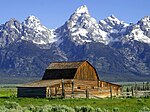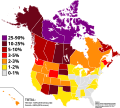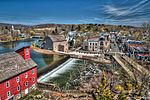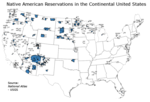Paleo-Indians were the first peoples who entered and subsequently inhabited the Americas towards the end of the Late Pleistocene period. The prefix paleo-...
58 KB (5,330 words) - 13:38, 3 August 2024
Indigenous peoples of the Americas (redirect from North American Indians)
The peopling of the Americas began when Paleolithic hunter-gatherers (Paleo-Indians) entered North America from the North Asian Mammoth steppe via the Beringia...
241 KB (24,800 words) - 08:15, 20 August 2024
dates back at least 11,000 years when the first nomadic hunter-gatherer Paleo-Indians began migrating into the region during warmer months to pursue food...
144 KB (15,007 words) - 21:30, 27 July 2024
comprised a separate migration into North America, later than the first Paleo-Indians. They migrated into Alaska and northern Canada, south along the Pacific...
360 KB (36,130 words) - 16:03, 21 August 2024
Kittatinny Mountain (section Paleo Indians)
gap is about 350 feet (110 m) deep. Culver's Gap was a route used by Paleo Indians and the Lenape Native Americans to go through the mountain to trade...
14 KB (1,805 words) - 12:27, 5 March 2023
History of Arizona (redirect from Paleo-Indians in Arizona)
encompasses the Paleo-Indian, Archaic, Post-Archaic, Spanish, Mexican, and American periods. About 10,000 to 12,000 years ago, Paleo-Indians settled in what...
66 KB (7,857 words) - 09:20, 22 August 2024
Paleo-Indians occupied the land in Ohio and ranged throughout the territory. They were hunter-gatherers who traveled seasonally for game. The Paleo-Indians...
32 KB (4,152 words) - 20:57, 23 May 2024
of thousands of years ago with the settlement of the Americas by the Paleo-Indians. Anthropologists and archeologists have identified and studied a wide...
116 KB (13,659 words) - 03:09, 15 August 2024
Peopling of the Americas (redirect from Origin of paleo-Indians)
The peopling of the Americas began when Paleolithic hunter-gatherers (Paleo-Indians) entered North America from the North Asian Mammoth steppe via the Beringia...
131 KB (13,781 words) - 11:09, 17 August 2024
Mesa Verde National Park (section Paleo-Indians)
7500 BC Mesa Verde was seasonally inhabited by a group of nomadic Paleo-Indians known as the Foothills Mountain Complex. The variety of projectile points...
103 KB (12,882 words) - 02:58, 12 May 2024
some of the earliest known sites of human habitation in Canada. The Paleo-Indian Clovis, Plano, and Pre-Dorset cultures predate the current Indigenous...
148 KB (12,854 words) - 23:44, 19 August 2024
Frankford Township, New Jersey (section Paleo Indians)
The area was a Tundra Biome which grasses grew slowly. This is when Paleo Indians came into the area around 11,000 BCE. After several thousand years,...
48 KB (5,909 words) - 13:30, 27 May 2024
Indigenous peoples in Ecuador (redirect from Ecuadorian Indians)
Pleistocene or Early Holocene. The people of this culture are known as Paleo-Indians, and the end of their era is marked by the extinction of the megafauna...
45 KB (5,694 words) - 17:16, 15 March 2024
with early Paleo-Indians soon spreading throughout the Americas, diversifying into many hundreds of culturally distinct tribes. The Paleo-Indians were hunter-gatherers...
89 KB (9,882 words) - 18:57, 12 August 2024
History of the United States (section Paleo-Indians)
level caused by the melting glaciers. These early inhabitants, called Paleo-Indians, soon diversified into hundreds of culturally distinct settlements and...
308 KB (29,904 words) - 09:16, 22 August 2024
"Hunterston" in Ayrshire, Scotland, the name "Hunterdon" was derived. Paleo Indians moved into Hunterdon County between 12,000 BCE and 11,000 BCE. The area...
83 KB (6,722 words) - 12:54, 18 June 2024
indigenous to the Americas. Arriving about 10,000 years ago alongside Paleo-Indians, today they make up a fraction of dog breeds that range from the Alaskan...
17 KB (1,755 words) - 07:30, 23 June 2024
Mesoamerican chronology (section Paleo-Indian period)
divides the history of prehispanic Mesoamerica into several periods: the Paleo-Indian (first human habitation until 3500 BCE); the Archaic (before 2600 BCE)...
74 KB (8,856 words) - 14:36, 15 July 2024
history of Phoenix, Arizona, goes back millennia, beginning with nomadic paleo-Indians who existed in the Americas in general, and the Salt River Valley in...
80 KB (9,588 words) - 06:01, 15 August 2024
Mesoamerica (redirect from Meso-American Indian)
chili, as well as the turkey and dog, resulted in a transition from paleo-Indian hunter-gatherer tribal groupings to the organization of sedentary agricultural...
92 KB (10,193 words) - 02:00, 18 July 2024
The land that is present-day Baltimore was used as hunting ground by Paleo-Indians. In the early 1600s, the Susquehannock began to hunt there. People from...
260 KB (23,384 words) - 02:21, 20 August 2024
of Sussex County, New Jersey spans over 13,000 years from the time Paleo Indians arrived after the Wisconsin glacier melted to the present day, and the...
56 KB (8,833 words) - 01:12, 29 January 2024
government's responsibility and involvement with Indians and to force their assimilation. The Indians would lose their lands but were to be compensated...
81 KB (10,183 words) - 02:35, 14 August 2024
Southwest prior to European contact. According to most archaeologists, paleo-Indians initially followed herds of big game—megafauna such as mastodon and...
15 KB (1,973 words) - 06:23, 11 September 2023
The state's history traces back to around 9500 BC with the arrival of Paleo-Indians, evolving through periods marked by the development of agricultural...
165 KB (16,883 words) - 05:17, 14 August 2024
Indigenous people of the Everglades region (redirect from Everglades Indians)
approximately 14,000 to 15,000 years ago, probably following large game. The Paleo-Indians found an arid landscape that supported plants and animals adapted to...
32 KB (4,160 words) - 02:27, 16 February 2024
population of any U.S. state. Archaeological evidence for the presence of Paleo-Indians in Arizona dates back at least 13,000 years. Over subsequent millennia...
31 KB (2,565 words) - 21:11, 1 July 2024
Lithic stage (category Paleo-Indian period)
Paleo-Indian period, which subsequently is divided into more specific time terms, such as Early Lithic stage or Early Paleo-Indians, and Middle Paleo-Indians...
12 KB (1,286 words) - 15:20, 24 July 2024
Ancient Beringian (category Paleo-Indian people)
until the time of USR1, some 8,000 years later. The lineage of other Paleo-Indians diverged from AB at ca. 20–18 kya, and further divided into "North Native...
10 KB (968 words) - 00:45, 2 July 2024
modern scholars. Paleo-Indians, c. 18,000–8000 BC Clovis Folsom tradition Plano cultures Cody complex Archaic Period, 8000–1000 BC Paleo-Arctic tradition...
15 KB (1,091 words) - 02:07, 6 July 2024


























